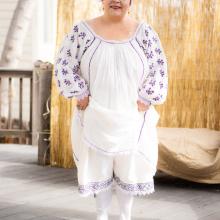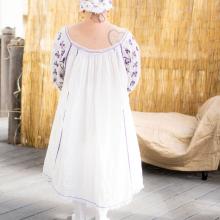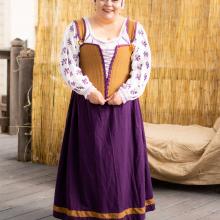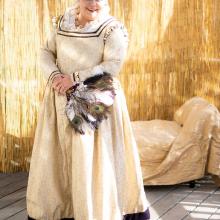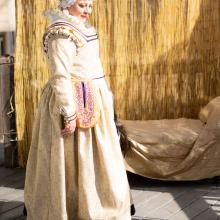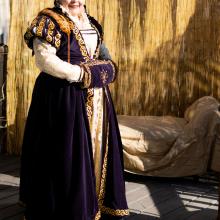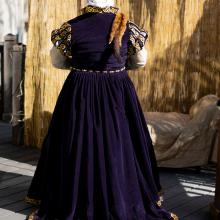Inspiration for the overall style of this outfit came from the portrait of Selvaggia di Baldo Fiervanti painted by Niccolo di Giovanni Betti in approximately 1570. This project consists of several layers of clothing. The first layer would be the undergarments including a pair of brache (italian for bloomers or drawers) based on an extant pair in the Met Museum, a camicia (shift or chemise) based on an extant camicia housed in the Met Museum and detailed in Patterns of Fashion 4, calze (stockings) based on an extant pair in the Met Museum, and cinte per gambe (garters) based on an extant card woven garters held in the Museum of Colonial Williamsburg. The second layer is a structural layer that consists of a sotanne (petticoat) and busto di sotto (stays) based on the Allesandro Allori’s Fresco "A Woman at her Toilet", as well as a gorgiera (partlet) that is based on Allesandro Allori's “Portrait of a Lady” (probably Camilla Martelli) from the 1570s. The third layer consists of a sottana (gown) that is similar in construction to the burial dress of Eleanor of Toledo and the Red Dress of Pisa as outlined in Patterns of Fashion 3. The final layer is the zimarra (overgown) that is similar in construction to the extant dress of Dorothea Sabina von Neuburg as outlined in Patterns of Fashion 3 and is constructed to resemble the initial inspiration portrait.
2 yards of medium weight white linen
5 yards of handkerchief weight white linen
5.5 yards of medium weight weight purple linen
1.5 yards of bronze dupioni silk
2 yards Linen Canvas
2 yards White Silk Cotton Blend Fabric
7 yards White & Gold Silk Blend Brocade
2 yards of Purple Silk - hand dyed
2 yards of Linen Canvas
4 yards of White Cotton Muslin
2 yards White Wool Felt
6 yards of Purple Cotton Velveteen
Thread, Scissors, Pins, Needles, etc.
Embroidery Hoop
Silk Embroidery Yarn in Purple & Black & White
White machine made lace in 2 Styles.
Machine Embroidery Hoop
Sulky Machine Embroidery Thread in Purple & Gold
Digital Machine Embroidery Files
Water Soluble Interfacing
Sewing Machine & Serger
Cotton Crochet Thread in Purple & Ecru
Brass Rings
Hooks & Eyes
3 yards of gold & White braided trim
1 yard of ribbon elastic
Upholstery Weight Thread in White, Purple, & Cream
Fusible Interfacing
Japanese Gold Thread from DMC (6 Spools)
3 yards Ecru Poly Decorator Cord
2 yards of Gold Poly Decorator Cord
4 yards of Gold Silk Ribbon
10 yards of Gold Trim
Brass Aiglets
Glass Pearls
Brass Jewelry Findings
Jewelry Pliers
Rit Dye
Please see the uploaded pdf for the construction details of each of the items making up the complete outfit.
Bibliography
Primary Sources:
Anea. “Extant Italian Dresses.”Anea's Costume Files, aneafiles.webs.com/renaissancegallery/extant.html. Images are the website owner's personal images. Must be accessed through the wayback machine.
Alcega, Juan de., and J. L. Nevinson.Tailors pattern book, 1589: facsimile. Costume & Fashion Press, 1999.
Arnold, Janet.Patterns of fashion. Vol.3, MacMillan Publishers Ltd., 1985.
Arnold, Janet. Patterns of Fashion . Vol. 4, Macmillan Publishers Ltd, 1984.
“Garter.” – Works – The Colonial Williamsburg Foundation, 1 Jan. 1970, emuseum.history.org/objects/461/garter?ctx=720990273e673da41f6868dad0439889f251c927&idx=6.
Gnagy, Mathew, and A. LaPorta. The Modern Maker, Vol. 2: Pattern Manual, 1580-1640. Printed by Creativespace.com, 2018.
Orsi-Landini, Roberta, and Bruna Niccoli.Moda a Firenze 1540-1580: lo stile di Eleonora di Toledo e la sua influenza. Polistampa, 2005.
Paganino, Alessandro, and Ugo Baroncelli. Il Burato, Libro De Recami. Ristampe Anastiche, 1538, Internet Archive, archive.org/details/ilburatolibroder00paga/mode/2up.
“Stockings, 16th Century Italian.” Metmuseum.org, www.metmuseum.org/collection/the-collection-online/search/83870.
“Tousers, Italian.” Metmuseum.org, www.metmuseum.org/art/collection/search/83869.
Secondary Sources:
Lozano, Carolyn. “Inkle Loom Pattern Generator.” The Carolingian Realm, carolingianrealm.blog/PatternGenerator.php
Making an Elizabethan Corset Pattern, www.elizabethancostume.net/corsets/pattern.html.
Sundström , Amica, and Maria Neijman. “Historical Textiles by Two Textile Nerds.”Historical textiles, 3 Nov. 2017, historicaltextiles.org/. Cross posted to Blog on Facebook on the same date.
I am working on getting all of the pieces and parts blogged into a dress diary. https://mandyrenee1976.wixsite.com/florentinelady/blog
This project was started April of 2020 and was worked on through January 2021. 10 months and 41 yards of fabric, not including the mock ups. This project was a challenge because I had previously started a skin out project but never got completely finished and would get side tracked to other projects. This is project should be listed under Bring Your Best.


